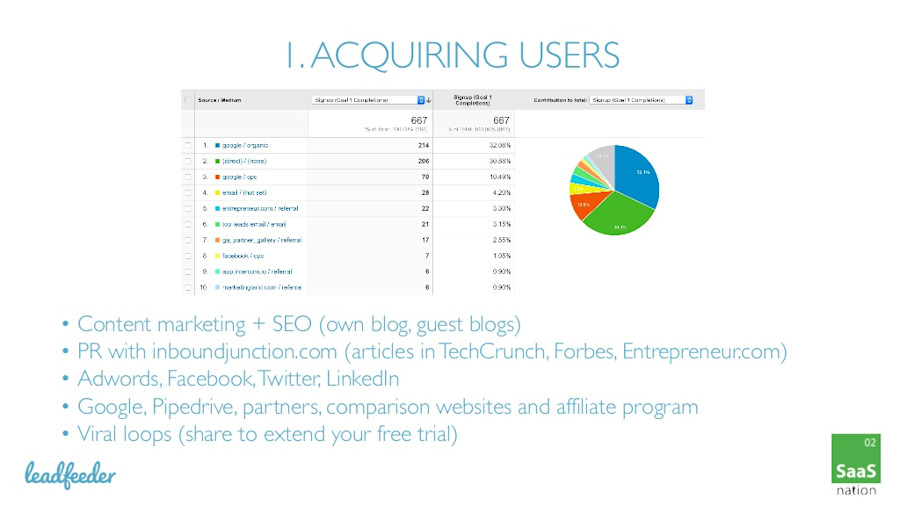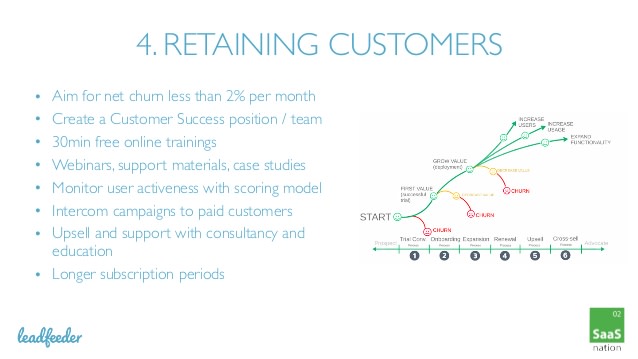With my first SaaS startup, Snoobi, the aim was to conquer the Finnish market, which we did.
The next step was to build on that success. We tried to grow the sales team and scale internationally, but we were in for a surprise…
Internal acquisition costs soared and cannibalized customer lifetime value (CLV), putting a stop to our plans to scale.
Expanding our operations overseas was borderline impossible because Snoobi’s structure was incompatible with international growth.
In comparison to Snoobi, Leadfeeder has been built from the ground up with global growth and scale in mind.
This approach has allowed Leadfeeder to scale to $500K in monthly recurring revenue without salespeople, attract investor attention, and develop a product that our users love.
Ahead, I’m lifting the bonnet to give you a deeper look into the strategies, channels, and actions that empower Leadfeeder to have a human touch at a “superhuman scale”.
Note: Sign up for Leadfeeder's free 14-day trial to scale your sales and increase predictable revenue by using our buyer intent data to guide your outreach.
1. Respect the MVP
For me, the launch of a minimum viable product (MVP) is an iconic eureka moment. It also plays a defining role in how you scale your SaaS company.
At Leadfeeder, for example, we knew we had a product valuable enough to attract users.
But, we needed to prove that value on the marketplace and confirm that customers would pay for our product.
So we invested upwards of $500,000 in Leadfeeder during the first year to not only develop, but also validate our MVP and gain enough traction to attract investors.
After 3-4 months of working to get an MVP together, we published it as a free service and drove traffic to the product for an entire year.
Our main goal was to make sure people found Leadfeeder valuable. Unfortunately, this is an initial step that most SaaS companies who fail to scale overlook.
They prematurely jump to paying users when they should invest more time in testing, validating, and gathering feedback.
Because we invested upfront into a strong MVP, Leadfeeder launched from a foundation ready for rapid growth.
We constantly learned from user behavior analytics, collected cornerstone feedback, and refined our features based on the input from users.
2. Follow a multichannel acquisition method
It’s tempting to stick to one strategy or channel for acquiring users. But, this isn’t optimal for growth.

The journey to the first $150K in MRR was done without salespeople. We did this by generating "hands-off" revenue via digital channels, and invested upfront in both paid and organic acquisition strategies like:
Referral/reward systems
Content marketing to optimize SEO
Paid advertising on Google, LinkedIn, Twitter, and Facebook
PR support to drive brand awareness and mentions on high-profile publications like Entrepreneur, Forbes, and TechCrunch
If we relied exclusively on organic channels like SEO or word of mouth, we wouldn’t have scaled as fast as we did.
These channels might have lower acquisition costs, but they take months to yield significant results. That’s why we invested heavily in Google Ads and PR campaigns simultaneously.
Because alongside the influx of traffic, came users, and those users provided pivotal performance data that blossomed into more opportunities for exponential growth.
3. Use Google Analytics to find and fix friction in your sales funnel
Using Google Analytics, we’ve accelerated user acquisition by finding and fixing pages with high-interest drop offs. For example, after reviewing our:
High exit pages
High bounce rate pages
High traffic or click-through-rate pages (CTR) with low conversions
We found that users were dropping off while browsing Leadfeeder pricing pages.
After discovering this, we fixed the key issues harming conversion rates. This included revamping our pricing page to make plans clickable and optimizing design.
After implementing these changes, pricing page conversions were up by 30 percent and we netted an additional $11,000 in monthly recurring revenue (MRR).
Making use of Google Analytics and Tag Manager, you can identify traffic from different sources, reveal opportunities to improve conversions, and create smoother campaigns.
The most difficult part of optimization is knowing what tests to run. It's part art and part science. I suggest you start with the science and let the art fall into place.
This means you should:
Get familiar with customer motivations and objections
Pair the above with web and behavioral analytics data
Run tests to address and fix glaring issues
4. Focus on acquisition as much as retention
A great product will attract users, but is it enough to retain them?
The number of Martech SaaS companies has jumped from 3500 to 7040 in the last 3 years. And in the past 5 years, customer acquisition costs have crept up by nearly 50 percent.
In the crossfire of a fiercely competitive marketplace, retention remains a key metric that I keep top of mind.
An awesome product gets you a foothold in the market, but retention enables your SaaS company to keep climbing and remain resilient when facing change.
Early on, we developed a robust onboarding and support system to improve retention.

One way we did this was by offering free 30-minute training sessions to users. This might seem counterintuitive when you consider that they’re only paying an average of €55/month.
But we quickly realized that after a training session, users were 40 percent more likely to convert.
During the first 4 weeks of sign-up, we also have over 200 Intercom messages ready to answer any questions a customer may have, or offer the aforementioned training sessions.
Developing on retention, we also invested in a customer success team that focuses purely on supporting our customers.
Look, it’s normal for acquisition to take priority during early-stage growth.
However, once you’re stable, continuing to singularly focus on acquisition while neglecting retention harms your ability to scale.
It creates a “leaky bucket” situation where customers churn at the same rate you acquire them.
Once you’re out of the hustle stage, prioritize retention as much as acquisition. This will give you the peace of mind to continue scaling without looking over your shoulder to “plug” churn.
Sharpen your axe, first
“Give me six hours to chop down a tree and I will spend the first four sharpening the axe.” Abraham Lincoln
Scaling Leadfeeder took significant investment, close attention to data, an obsession with customer feedback, and above all, a lot of patience.
The truth is: most startups fail because they’re in a rush to scale.
They neglect CAC, retention, and product-market fit. They fail to validate and rush to monetize. My advice?
Do the opposite.
Create a valuable MVP, listen to your customers, fall in love with collecting feedback and refining features.
Sure, it may take longer to monetize. But when the time comes to scale, you’ll achieve exponential growth at lightning speed.
Note: Sign up for Leadfeeder's free 14-day trial to scale your sales and increase predictable revenue by using our buyer intent data to guide your outreach.
Get more from your web analytics.
t’s time to turn your website traffic data into something more meaningful. Website visitor analytics enable you to identify and qualify the companies visiting your website, even when they don’t fill out a form.
Show me how







